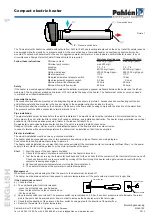
3
FOREWORD
This design complies with CAN1-4.3-77 and ANS1Z21.10.3b
1994 as an instantaneous gas water heater. In addition the
unit complies with CAN1-2.17- M80 use at high altitude,
2.000- 4.500 feet above sea level.
Installation, operation and maintenance information is
provided in this manual . Installation and operation
instructions should be thoroughly reviewed before
proceeding with installation of the BOSCH instantaneous
gas water heater.
The BOSCH instantaneous gas water heater is designed
to operate on natural or propane gas; however
make sure
that gas on which heter is to operate is the same as specified
on the heater’s model/rating plate.
In addition of these instructions, the water heater shall be
installed in accordance with CAN1-B149 Installation Code
(in Canada) or ANSI Z223-1/NFFA 54 National Fuel Gas
Code (in U.S.) and/or local installation codes.
These shall be carefully followed in all cases.
INSTALLATION INSTRUCTIONS
Note: Proper plumbing, venting, gas connections and an
adequate supply of combustion air are required for
safe and reliable operation. Ability equivalent to that
of a licensed tradesman in the field involved is required
for installation and/or service of these water heaters.
LOCATION
Before installing the BOSCH instantaneous water heater
consideration must be given to proper location. The location
should be as close to a chimney or gas vent as practicable,
in an area with an adequate air supply and as centralized
with the piping system as possible. The heater should not
be located in an area where it will be subject to freezing.
The heater should be located in an area where leakage of
the heater or its connections will not result in damage to
the area adjacent to the heater or to lower floors of the
structure.
Note:
When such locations cannot be avoided, it is
recommended that a suitable drain pan, adequately
drained, be installed under the water heater. The
pan must no restrict combustion air flow.
AIR REQUIREMENTS
For safe operation, sufficient air combustion, ventilation and
dilution of the flue gas must be available. An insufficient
supply of air will result in a yellow luminous burner flame,
causing carboning or sooting of the heat exchanger.
In order to prevent corrosion, make sure that the combustion
air is kept free of aggressive substances. Substances that
especially contribute to corrosion are halogenated
hydrocarbons (e.g., chlorine and fluorine) which are
contained in solvents, paint, adhesives, propellant gases,
various household cleaners, etc. Take precautionary
measures as necessary.
In unconfined spaces, in buildings of normal construction,
infiltration normally is adequate to provide air for combustion,
ventilation and dilution of the flue gases. However, a confined
space must be provided with two permanent openings to
provide combustion and ventilation air to the appliance. Each
opening shall have a free area on one square inch per 1,000
BTU/Hr* of total input rating of all the appliances in the
enclosure. One opening shall be within 12 inches of the top
and one within 12 inches of the bottom of the enclosure.
*Special Note
When the WR400-1 is installed in a confined space of
minimum size the openings described above must be
increased in to a size of 1 ½ square inches per 1,000 BTU/
Hr. In order words, when the WR400-1 is installed in a
minimum sized confined space the two openings that are to
be made in the enclosure within 12 inches of the top and
12 inches of the bottom must each have a minimum free
area of (1 ½ “) x (117) = 175.5 square inches.




































